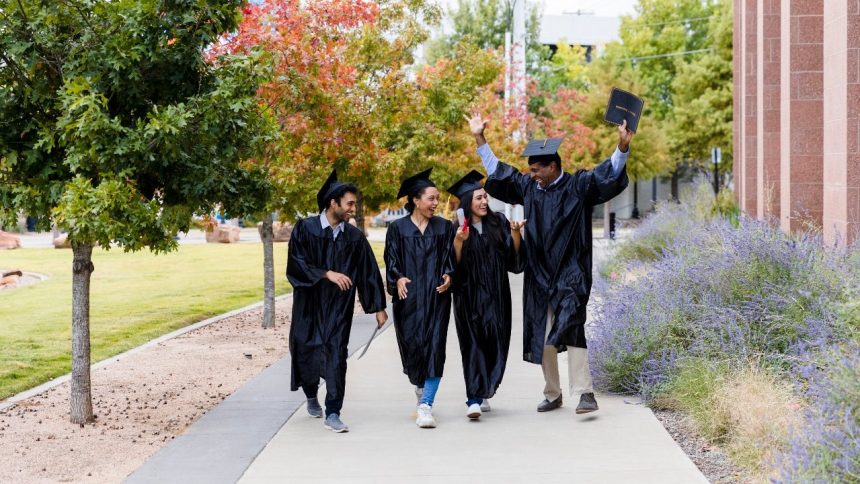SDI Productions/Getty Images
Key takeaways
- Even though enrollment numbers are up, many college students don’t graduate.
- Nearly two-thirds of college students who enroll will complete their degrees within six years.
- The rest — about 40 percent — will leave school without graduating.
Many students who enroll in college don’t graduate. The most recent data shows that, as of 2022, almost 40 percent of undergraduate students in the U.S. started — but didn’t graduate — college.
Financial concerns are a major barrier for students completing postsecondary degree programs, especially for those without great credit or who are from low-income backgrounds. Even with federal financial aid and loan options, many have trouble qualifying for the aid they need. Rather than rack up massive debt in college, many will avoid excess borrowing and dropout altogether.
Key graduation rate statistics
- By 2023, 62.2 percent of students who started college full-time in 2017 earned a bachelor’s degree at that institution.
- Public colleges have an average graduation rate of 63 percent, and private nonprofit schools have a rate of 68 percent.
- Women are more likely than men to graduate within six years of starting their degree program at public and private nonprofit schools.
- Roughly 45 percent of students graduate from public four-year schools without student debt, and 83 percent graduate with less than $30,000 in debt.
- In the 2024-2025 academic year, it’s projected that just under 2.17 million bachelor’s degrees will be awarded in the U.S.
- Millennials are more likely to earn a bachelor’s degree than people from older generations.
- Of people who don’t enroll in college or drop out, 55 percent of people indicate the cost of the program was the cause, and 45 percent cite affordability concerns due to inflation.
College dropout rates
College enrollment and completion rates went down significantly at the start of the COVID-19 pandemic. As of the 2024-2025 school year, enrollment is just now starting to rebound to pre-pandemic levels.
- Roughly 40 percent of undergraduate students who start their college path drop out.
- More than one-third of Black students (34.1 percent) drop out within six years of enrolling in college — the highest amount when broken down by race.
- Reasons for dropping out include lack of affordability, motivation shifts, life changes and mental health, among others.
- While many factors could impact a student’s decision to drop out of college, financial concerns are a known barrier to completing degree programs. Students from low-income households are far more likely to drop out than students from high-income backgrounds.
Average graduation rates
Graduation rates are typically defined as the percentage of students who graduate from a program within four or six years of starting at that institution. But graduation rates are not a perfect reflection of the total student population. For example, most measurements exclude part-time and transfer students.
According to the National Center for Education Statistics, 64 percent of full-time students graduate within six years. However, that number is higher at private nonprofit institutions and lower at private for-profit and public institutions.
While undergraduate enrollment sharply declined in recent years due to COVID-19, enrollment is now up above pre-pandemic levels for the first time. In fall 2024, enrollment was 0.4 percent higher than in 2019.
Graduation rates by demographic
Graduation rates differ across gender, age, race and a multitude of other demographics. When it comes graduation, race and ethnicity as well as sex and gender are some of the most impactful.
Race/ethnicity
Race plays a significant role in educational attainment in the U.S. white and Asian students are far more likely to graduate within six years compared to Black and Hispanic students. The Hechinger Report found money as the main reason. Structural inequities mean that Black and Hispanic students may need to hold a job while in college or attend expensive additional classes to make up for inadequate high school preparation. This, combined with social pressures while on campus, could contribute to lower graduation rates for marginalized groups.
| Race/ethnicity | Bachelor’s degree recipients within 6 years of enrollment at non-R1 doctoral institutions |
| White | 65.8% |
| Black | 38.9% |
| Hispanic | 57.4% |
| Asian | 55.9% |
| Two or more races | 62.6% |
Sex/gender
Women graduate at a higher rate than men: 62.3 percent compared to 56.9 percent at a non-R1 doctoral institute, according to the 2024 Race and Ethnicity In Higher Education Status Report. Within six years, women complete an undergraduate degree or certificate at a higher rate — 70.4 percent — compared to men — 63.5 percent.
Only Hispanic and Latino men graduated at a higher rate compared to Latina women: 60.7 percent compared to 55.5 percent, respectively.
Graduation rates by school
Some colleges have higher graduation rates than others; for instance, students at Ivy League institutions are much more likely to graduate within six years than students at lesser-known public or for-profit schools. Here are the top 10 U.S. colleges with the highest and lowest graduation rates.
Colleges with the highest graduation rates
| College/university | Graduation rate | |
| Charter Oak State College | 100% | |
| University of Notre Dame | 97% | |
| Harvard University | 97% | |
| Williams College | 97% | |
| Princeton University | 97% | |
| University of Pennsylvania | 97% | |
| Yale University | 96% | |
| Northwestern University | 96% | |
| Bowdoin College | 96% |
Graduation rates by state
College graduation rates in the U.S. also vary by state. Rhode Island, Connecticut and Vermont hold the highest graduation rates, while New Mexico and Montana have graduation rates below 40 percent.
States with the highest graduation rate
| State | Graduation rate |
| Rhode Island | 68.08% |
| Connecticut | 66.09% |
| Vermont | 59.27% |
| Massachusetts | 58.29% |
| Florida | 57.48% |
States with the lowest graduation rate
| State | Graduation rate |
| New Mexico | 33.76% |
| Montana | 39.57% |
| Alabama | 41.00% |
| Arizona | 41.38% |
| Georgia | 42.17% |
Graduating with student loan debt
According to the College Board, average tuition and fees for the 1994-95 school year at four-year public institutions were, after adjusting for inflation, $5,740 per year. For the 2024-25 school year, it was $11,610 per year.
The vast majority of federal student loan borrowers are graduating with $20,000 in student loan debt or less, despite the rising cost of college. According to the College Board, 47 percent of those who graduated with a bachelor’s degree in 2023 with student loan debt averaged $20,100 per borrower.
Bottom line
College students can increase their chances of graduating on time by working closely with their academic advisor, taking advantage of financial aid and choosing a field of study that interests them. And even though many students don’t graduate within the standard timeframe for their program, a degree is still within reach — it’s possible to extend a degree program or even come back for a degree later on in life.
Read the full article here














